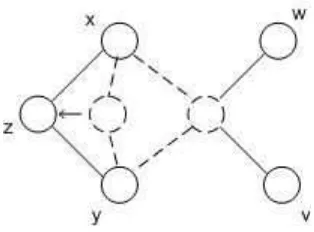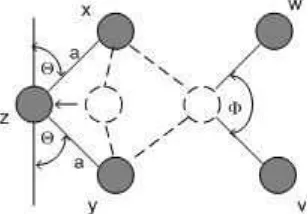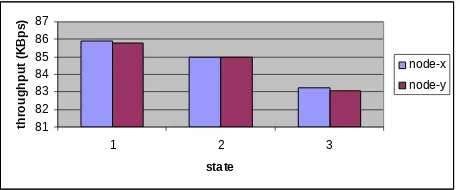Dynamics System Modeling Approach in Node Mobility on
Mobile Ad-hoc Network
S.N.M.P. Simamora
Department of Telecommunications, STEI, ITB Jl. Ganesha No. 10 Bandung 40132 - Indonesia
Abstract— Movement of the nodes in a mobile ad-hoc network is affected by distance and strong transmit / receive signal between neighboring nodes to each other, so how the mobility of the nodes in the network connection can maintain connectivity in the line-of-sight is emerging challenges in the dynamics system. In mobile ad-hoc network each connection connectivity is temporary, so the topology changes that appear along with the mobility of the nodes in constructing communication calls will change the position of the transmitter and receiver. This research has been done on modeling the dynamics system approach for each node mobility scenarios were created based on the selected tests and determined. With quantitative methods used involve tools that can observe the data streaming process in real-time, the results obtained demonstrate the system dynamics can serve to test the mobility of the nodes that occur in mobile ad-hoc network is able to maintain a connection connectivity between each neighboring node.
Keywords: dynamic system, mobile ad-hoc network, modelling, node-mobility
I. INTRODUCTION
The movement of the nodes in the Ad-hoc network initiated when an end-user connectivity requires that new media infrastructure available at the time previously failed to provide the connection is successful; whereby a network service can be accessed if the previous interconnectedness between devices that need each other to build the communication has been intertwined. Compared to wireless networks that are point-to-multipoint, then Ad-hoc network, the infrastructure that is built up and formed is temporary and not permanent. This is what allows the mobility of nodes can be established adjacent to each other continuously throughout each connectivity can be maintained. Thus the nature of the dynamics of the movement of the nodes can be built, and technologies that use this method are called mobile ad-hoc network [1] [2]. When the ad-hoc network, a minimum of two nodes that are interwoven to form a network of relationships in building communication, then the mobile ad-hoc network there are at least three nodes form a network so that communications can be established among them [2][3].
In the mobile ad-hoc network each nodes adjacent to each other has changed the dynamic nature of each position in building communication calls. Dynamic properties can be built by any cause nodes in the network have the capability to act as backwarding / forwarding devices [4]. The mobile ad-hoc networks network itself are in the private network, that’s the computer network group that has wide coverage and domain are internal and are limited in building data communications and call [5].
On this research has been carried out a series of simulations that are based on quantitative empirical methods in modeling various node mobility conducted in indoor conditions-building [2] [3] [6]. In mobile ad-hoc network, each nodes adjacent to each other can be changed dynamically by calculating the distance range (line-of-sight, LOS) and transmit/receive signal strong [7]. Line-of-sight is the scope and reach of the transmit / receive signal between sender and receiver are formulated in Fresnell Zone area, and a transmit / receive signal strong is a signal condition value that is sent or received from the sender or the receiver.
Figure 1. Node mobility on mobile ad-hoc network [2]
II. RELATED WORK
It is tested on the dynamics system of the data communication is a QoS good conditions must be maintained before and after the node mobility occurs. Therefore, the dynamics of the system modeling should be possible QoS parameter values tend to be fixed and unchanging.
If on the analog communication systems, quality of service expressed in transmit/receive signal strong; hence in digital communication systems is expressed in the parameters: delay (δ), throughput (Γ), jitter (ϕ), and packet-loss (π).
Figure 3. Node mobility in line-of-sight on mobile ad-hoc network
In mobile ad-hoc network, a position of a node is expressed in two parameters, and based on [8] in the dynamics system there are two major elements that possessed namely vector and function. A vector represented stated direction as node dynamic, and in data communication it’s mean a distance and transmission/receipt signal strong; as well as the stated function node movement models are used, wherein the data communication is stated in the position shift is generally expressed in a mathematical model. Tendency of node mobility in mobile ad-hoc networks are more fixed/static when compared to similar networks virtually, namely mobile communications network.
Network models of mobile ad-hoc network which is constructed in this research are shown in Figure 4, which was twice the node mobility scenarios as shown in Figure 5 and 6.
Figure 4. Mobile ad-hoc network model on this research
Figure 5. Node z as mobility node for first
Figure 6. Node z as mobility node for second
If on the dynamic system has a feedback in order to maintain the value of the connectivity for initial state and after is not affected by dynamics being built, so in data communication the feedback can be represented by the line-of-sight. Classification of line-of-sight consists of an optical line-of-sight, ie, the transmitter and receiver can keep each viewing (face-on-face); and radio line-of-sight, ie, the transmitter and receiver can keep listening to each other [9].
Dynamics system models are generally based on [4] [10] [11] is shown in (1).
Ax’ + Bx = 0 (1)
Where A and B respectively at the constant changes in the dynamics of inter-state by running on x conditions and its diffrential. Therefore, the dynamics system in order to provide the same quality before and after, then (1) can be translated back into (2).
Ax’ = -Bx (2)
So if the assumed changes in the inter-state mobility of nodes which occur on the dynamics system while maintaining quality of service in mobile ad-hoc network, (2) can be in the form of new formulated into (3) to (5).
∆k = Γ - δ - π (3) ∆k’ = Γ’ - δ’ - π’ (4) ∆ = |∆k - ∆k’| (5) Then the dynamics system are met if: 0 ≤∆< 1.
Quality of service is getting better or a positive value if δ getting smaller, the Γgetting greater, and π is near zero. Therefore the dynamics system in a mobile ad-hoc network must be able to defend the values of quality of service in accordance with the criteria of good.
The series of tests that have been carried out in this research using two scenarios as shown in Figure 5 and 6 earlier, where Wireshark tools used to observe the changes in Γ and δ value, while π assumed negligible.
III. RESULT
Figure 7. Node-z mobility on first scenario with position state
Figure 7. Node-z mobility onj second scenario with position state
In figure 6 and 7, the node mobility change only applies to node-z, while other nodes remain mutually conditioned neighbors to its original position. The position in a mobile ad-hoc network is in terms of the parameters of the distance and angle between each adjacent node.
TABLE I. ΓVALUEFORINITIALCONDITION
Node-x (KBps) Node-y (KBps) 86.13 86.09 86.29 86.02 85.92 85.93 85.89 85.82 85.33 85.21 Average: 85.912 KBps Average: 85.814 KBps
TABLE II. ΓVALUEFORFIRSTNODEMOBILITYSTATE
Node-x (KBps) Node-y (KBps)
85.7 85.69
85.19 85.12 85.11 85.09
84.69 84.9
84.13 84.12 Average: 84.964 KBps Average: 84.984 KBps
TABLE III. ΓVALUEFORSECONDNODEMOBILITYSTATE
Node-x (KBps) Node-y (KBps)
85.12 84.9
84.63 84.55 83.18 83.12
83.08 82.77 80.11 80.09 Average: 83.224 KBps Average: 83.086 KBps
TABLE IV. δVALUEFORINITIALCONDITION
Node-x (second) Node-y (second) 63.21 63.28
63.3 63.39
63.77 63.62 64.06 64.18 64.49 65.07 Average: 63.766 s Average: 63.908 s
TABLE V. δVALUEFORFIRSTNODEMOBILITYSTATE
Node-x (second) Node-y (second) 63.42 63.42 63.59 63.66
63.9 64.09
64.3 64.35
67.6 67.22
Average: 64.562 s Average: 64.548 s
TABLE VI. δVALUEFORSECONDNODEMOBILITYSTATE
Node-x (second) Node-y (second)
63.9 63.99
64.09 64.18 65.63 65.62 65.92 65.92
66.09 66.7
Average: 65.126 s Average: 65.282 s
Then further examination by the dynamics system approach in every states changes for the Γ and δ parameters which is as follows:
On the scenario-1 with Γ parameter is:
(85.912+85.814)/2 = 85.863 ssd ; satu-satuan-dinamika
On the scenario-1 with δ parameter is:
(63.766+63.908)/2 = 63.837 ssd ; satu-satuan-dinamika
Counting on ∆k parameter is:
85.863 - 63.837 = 22.026
81
TABLE VII. DYNAMICSYSTEMVALUEONNODEMOBILITYBASED SCENARIOS dynamics system modeling showed significant changes to the quality of service parameters. Changes obtained show node mobility on the first movement got 1,607, and while in the 2nd movement gained 2,468.
However, if viewed from the change in the value of each Γ and δ parameter to nodes observed at each node mobility, then the result obtained does not really give a significant change as shown in Figure 8.
Figure 8. Γ and δ value on each node-x and y
Figure 9. δ value on each node-x and y
This situation is in accordance with [6] that the two nodes are observed when the same position relative to the reference node, then the quality of service parameters are measured at each node are relatively equal.
Thus the node mobility that occurs for node-z displacement, although with conditions other nodes are mutually adjacent on observations made at nearby nodes, namely node-x and y represent the dynamics system being modeled exert significant influence on changes in quality of service measurable.
The results of observations made indicate any change in displacement node-z give significant effect on the Γand δ parameters. Although qualitatively (such as in terms of end-user) shows relative differences can be ignored, but
when viewed from a quantitative approach (such as from the machine) then the result is significant given the change. This is caused by the transmit/receive signal interference on each node is observed by the implications of the node-z movement position.
IV. CONCLUSION
The node mobility in mobile ad-hoc network is affected by the transmit/received signal strength between the nodes adjacent to each other, so that the switching node tendency to follow the needs and desires of end-users. Data communication can be accomplished if the first connectivity between the nodes that want to build the call has been going and going well.
Dynamics system provides flexibility in terms of value with the criteria of node mobility while maintaining quality of service of any ongoing communication calls. Flexibility in mobile ad-hoc network expressed in node position movement at the area of line-of-sight is formed.
Coverage area of node mobility on line-of-sight can not ignore the changes in the transmit/receive signal on each node. Even if from a qualitative approach does not exert significant influence, but if the node mobility of a quantitative approach is sufficient to give the change in the ratio of Γ and δ parameter measurable.
Based on the test results and calculations indicate node mobility affects the value of the position represented in the distance and angle to the value of the Γ and δ parameter observed for any and inter-state migration is performed. And node mobility have lower tendency quality of service in mobile ad-hoc network. Therefore, the dynamics system has elements of feedback in communication where the data represented in the routing technique. With routing techniques, packet-data will be forwarded to the neighboring nodes that have good support in connectivity.
At a certain state due to changes by node mobility in mobile ad-hoc network, based on the test results, showing inverse ratio between the value of Γ and δ. Where any change Γ give rise to changes impairment δ parameter.
ACKNOWLEDGMENT
Thanks a lot to the members of PUSDITEK (Center for the Study of Wireless Technology and Mobile) TELKOM Polytechnic to support the infrastructure and personnel in the experiments of this research especially when testing was conducted.
REFERENCES
[1] Y. Ye, C. Hua, S. Seung-Woo. "Performance Analysis of IEEE802.11 Wireless Mesh Networks". IEEE International Conference on Communications, 2008. ICC '08. p.2547-2551. [2] S.N.M.P. Simamora, T. Juhana, Kuspriyanto, N. R. Bagjarasa.
[3] S.N.M.P. Simamora, T. Juhana, Kuspriyanto, A. L. Fajarini. ”Pemodelan Graf dalam Jalur Komunikasi Data pada Mobile Ad-Hoc Network”. Proceeding Of KNSI, 14–15 Februari 2013, hal.221-226 STMIK Bumi Gora, Mataram, Indonesia. ISBN: 978-602-17488-0-0
[4] J.W. Dean, J.P. Macker, W. Chao. "A study of Multiagent System operation within dynamic ad hoc networks". IEEE Military Communications Conference, 2008. MILCOM 2008. p.1-7 [5] A. Abdrabou, Z. Weihua. "A Link-Layer Channel Model for IEEE
802.11 Ad Hoc Networks". IEEE Global Telecommunications Conference (GLOBECOM) 2007. p.881-886
[6] S.N.M.P. Simamora, M. F. Al Haris, A. Sularsa. "Analisis Kinerja Layanan VoIP pada Jaringan HotSpot dengan Pendekatan Perpindahan Terminal-Client". Proceeding SNIT (Seminar Nasional Inovasi dan Teknologi) 13 Juni 2012, Univ. BSI. Bandung. hal:21-29. ISBN: 978-602-99213-2-8
[7] I.W.-H. Ho, K.K. Leung, J. W. Polak. "Stochastic traffic and connectivity dynamics for vehicular ad-hoc networks in signalized road systems". IEEE 34th Conference on Local Computer Networks, 2009. LCN 2009. p.332-335
[8] X. Linfeng, X.R. Li, D. Zhansheng, L. Jian. "Modeling and State Estimation for Dynamic Systems with Linear Equality Constraints". IEEE Transactions on Signal Processing. Volume: 61, Issue: 11. 2013. p.2927-2939
[9] S. Basagni, I. Chlamtac, V.R. Syrotiuk."Dynamic source routing for ad hoc networks using the global positioning system". IEEE Wireless Communications and Networking Conference, 1999. WCNC. 1999. vol.1. p.301-305
[10] C. Chun-Hung, W. Ho-Ting, K. Kai-Wei. "A Novel Mobility Modelof Diverse Average Speed and Uniform Node Distribution in Mobile AdHoc Networks". IEEE,1-4244-0549-1, 2006. [11] W. Wongsason, C. Pirak, R. Mathar. "Adaptive Clustering in
MANETs Using Graph Theoretical Algorithms". International Conference on Electrical Engineering/Electronics Computer Telecommunications and Information Technology (ECTI-CON), 2010 p.789-793
![Figure 1. Node mobility on mobile ad-hoc network [2]](https://thumb-ap.123doks.com/thumbv2/123dok/2381851.1257138/1.595.315.521.338.693/figure-node-mobility-mobile-ad-hoc-network.webp)


